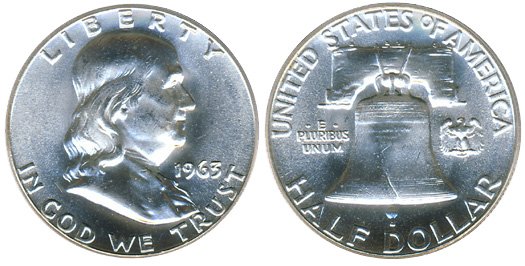Guide to U.S. Franklin Half Dollars
In 1948, the Franklin Half Dollar was introduced to replace the former Walking Liberty design. In a way, the new series represented the end of an era. The half dollar was the final circulating coin design in production to make the switch from a depiction of the allegorical Liberty figure to a portrait of an actual person. The cent had transitioned to a portrait of Abraham Lincoln in 1909, followed by George Washington on the quarter in 1932, Thomas Jefferson on the nickel in 1938, and Franklin D. Roosevelt on the dime in 1946. The half dollar would carry the portrait of Benjamin Franklin until the series was cut short in 1963.

The design for the series was created by United States Mint Chief Engraver John R. Sinnock. The obverse portrait of Benjamin Franklin was modeled after a bust created by French sculptor Jean-Antoine Houdon in 1778. Sinnock had made an earlier medal with the same bust of Franklin and had adapted it for use on the new circulating coin series. Franklin appears in profile, facing to the right. The inscription LIBERTY appears above, with IN GOD WE TRUST below, and the date to the right.
The reverse also features a design that Sinnock adapted from his earlier work. In this case, the design was based on the reverse of the 1926 Sesquicentennial of American Independence Half Dollar commemorative coin. The Liberty Bell appears at center, with its characteristic crack clearly visible. A diminutive eagle appears to the right of the bell, balanced by the inscription E PLURIBUS UNUM to the left. The unusual appearance of the eagle is the result of the legal requirement to place an eagle on the reverse of the denomination. The design is completed with the inscriptions UNITED STATES OF AMERICA above and HALF DOLLAR below.
The Franklin Half Dollar was produced across 16 years, comprising 35 different date and mint mark combinations. The series concluded prematurely in 1963, following the assassination of President John F. Kennedy. Under existing law, circulating coin designs were required to be used for at least 25 years before they could be changed. A bill was rushed through Congress both overruling the existing law and authorizing a new design to memorialize Kennedy starting in 1964.

